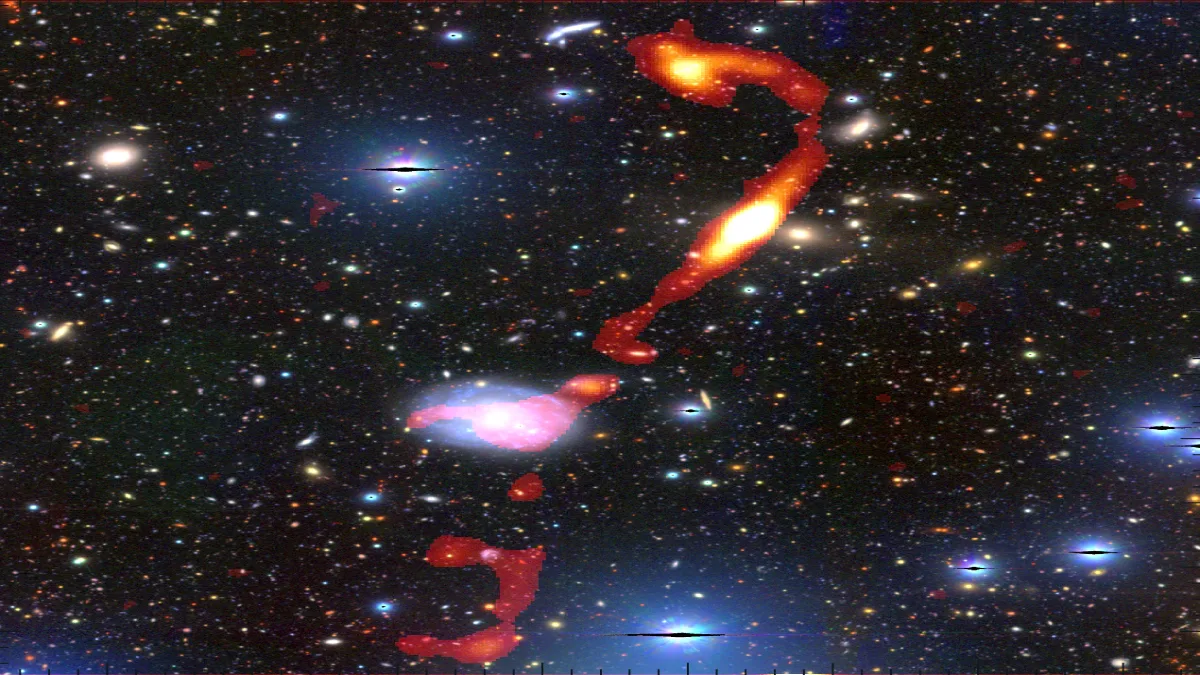
Researchers from the University of Cape Town (UCT) and the powerful MeerKAT radio telescope have identified a rare giant radio galaxy named Inkathazo.
This noteworthy finding, published in the Monthly Notices of the Royal Astronomical Society, illuminates these vast cosmic structures and presents intriguing challenges for astronomers as they strive to understand their unique characteristics.
A Rare Giant Radio Galaxy Named Inkathazo: Unveiling the Mysteries of the Universe
Giant radio galaxies (GRGs) are among the most expansive structures in the universe. These colossal entities consist of massive galaxies that emit plasma jets stretching millions of light-years through intergalactic space, all powered by supermassive black holes at their cores.
According to AOL, the number of GRG discoveries has surged in the past five years, thanks to advancements in radio astronomy—a trend exemplified by the capabilities of the MeerKAT telescope.
The Age of Giants: MeerKAT spots a troublesome cosmic beast
South Africa’s MeerKAT telescope has uncovered an extraordinary new giant radio galaxy nicknamed Inkathazo, meaning ‘trouble’ in the African Xhosa and Zulu languages.
🔗 https://t.co/IgKthmpNkf pic.twitter.com/IANFp7HsrU
— SARAO – South African Radio Astronomy Observatory (@SKA_Africa) January 20, 2025
Unusual Plasma Jets and Unique Characteristics: Inkathazo’s Distinctive Features
What sets Inkathazo apart from its peers is its strikingly unusual plasma jets that extend a staggering 3.3 million light-years—more than 32 times the size of the Milky Way.
The name Inkathazo, which translates to “trouble” in isiZulu and isiXhosa, aptly reflects the complexities and peculiarities of this galaxy. “It doesn’t have the same characteristics as many other giant radio galaxies,” commented Kathleen Charlton, a Master’s student at UCT and the first author of the study. “For example, the plasma jets have an unusual shape. Rather than extending straight across from end to end, one of the jets is bent”.
Advanced Technology and Spectral Age Maps: Tracking the Age of Plasma Jets
Utilizing the advanced technology of MeerKAT, researchers crafted high-resolution spectral age maps of Inkathazo. These maps enabled them to track the age of the plasma jets across varying regions, unveiling unexpected energy spikes in the electrons within the jets.
'Troublesome' radio galaxy 32 times size of Milky Way spotted. Astronomers have discovered a giant radio galaxy named Inkathazo, which is 32 times larger than the Milky Way. This galaxy was detected by the MeerKAT telescope and features unusually large plasma jets, challenging… pic.twitter.com/Mv7zPDrmPV
— Nirmata (@En_formare) January 20, 2025
This intriguing finding is likely attributed to collisions with hot gas located between galaxies in the cluster, challenging existing models of plasma physics and further emphasizing the intricacies of these cosmic giants.
The Role of MeerKAT and Future Prospects: Pioneering Discoveries in Radio Astronomy
Dr. Jacinta Delhaize, a researcher at UCT and a part of the team behind the 2021 publication, stressed the significance of MeerKAT in uncovering these celestial wonders.
“The fact that we unveiled three GRGs by pointing MeerKAT at a single patch of sky shows that there is likely a huge treasure trove of undiscovered GRGs in the southern sky,” she remarked. As the operational groundwork for the forthcoming Square Kilometre Array (SKA), MeerKAT has established itself as a pioneering instrument for astronomers delving into the uncharted territories of the southern sky. “We’re entering an exciting era of radio astronomy,” Dr. Delhaize added.
“While MeerKAT has taken us further than ever before, the SKA will allow us to push these boundaries even further and hopefully solve some of the mysteries surrounding enigmatic objects like giant radio galaxies”.
This groundbreaking discovery of Inkathazo reinforces the pivotal role of South Africa and the University of Cape Town in advancing humanity’s grasp of the universe. It highlights the significance of cutting-edge research and international collaboration in decoding the mysteries of our cosmos.

